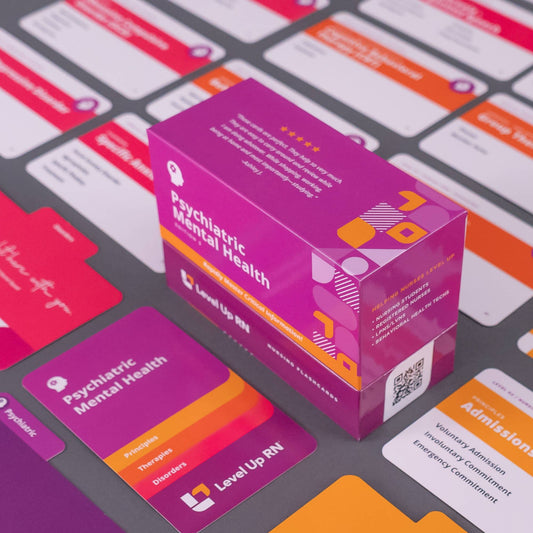Psychiatric Mental Health, part 28: Disorders - OCD & PTSD
Updated: Cathy ParkesObsessive Compulsive Disorder (OCD). Obsessions and compulsions, diagnosis of OCD, treatment of OCD, and nursing care of patients with OCD. Post Traumatic Stress Disorder (PTSD). Risk factors, signs/symptoms, diagnosis, treatment, and nursing care of patients with PTSD.
Full Transcript: Psychiatric Mental Health, part 28: Disorders - OCD & PTSD
Full Transcript: Psychiatric Mental Health, part 28: Disorders - OCD & PTSD
Hi, I'm Cathy with Level Up RN. In this video, we are going to be talking about obsessive-compulsive disorder and post-traumatic stress disorder. So if you have our Level Up RN flashcards, definitely pull them out so you can follow along with me. And at the end of the video, I'm going to give you guys a little quiz to test your knowledge of some of the key points I'll be covering. So definitely stay tuned for that. Obsessive-compulsive disorder is characterized by obsessions and compulsions. Obsessions are unwanted, intrusive thoughts, urges, or images that cause anxiety, such as fear of contamination or fear of harm. Compulsions are repetitive thoughts, behaviors or rituals that are performed in response to obsessions in order to decrease anxiety. So this can include repetitive handwashing or repeatedly checking the lock on a door. Individuals with OCD tend to be inflexible and preoccupied with rules, order, and perfectionism. OCD is diagnosed when an individual's obsessions or compulsions are very time-consuming and interfere with social or occupational functioning. In terms of treatment of OCD, cognitive behavioral therapy is particularly effective. Medications can be used, such as SSRIs or antipsychotics. And in terms of nursing care, you want to provide a structured environment for the patient and help the patient learn relaxation techniques. In the beginning of treatment, you want to allow for plenty of time for the patient to perform their rituals. But over time, you want to gradually limit the amount of time allotted for these behaviors.
Moving on to post-traumatic stress disorder. PTSD is a disorder that develops in response to a traumatic event, such as child abuse or sexual assault or a near-death experience. For example, someone in the military who comes out of combat experience. So the symptoms of PTSD are incredibly important to know in nursing school. And they would really lend themselves well to a select all that applies type question, so you have to know them Symptoms of PTSD include insomnia, nightmares, flashbacks, hypervigilance, irritability, difficulty concentrating, an exaggerated startle response, as well as a feeling of detachment from others. PTSD is diagnosed when a traumatic event or stressor precedes the onset of symptoms, and the symptoms are severe enough to interfere with the individual's social and/or occupational functioning. Treatment of PTSD includes cognitive behavioral therapy, as well as EMDR, which is eye movement desensitization and reprocessing. So if you need more information about CBT or EMDR, I have another video in this playlist that goes into more details about those therapies. Medications that are helpful in the treatment of PTSD include SSRIs, SSNRIs, as well as trazodone for sleep assistance. In terms of nursing care, safety is top priority. So we want to assess our patient for suicide risk and make sure we stay with our patient during periods of flashbacks or nightmares. We also want to assess our patient for maladaptive coping, such as substance abuse, and encourage healthy coping mechanisms, such as deep breathing as well as exercise.
All right. It's quiz time, and I've got three questions for you. Question number one. When caring for a patient with OCD, how much time should be allowed for ritualistic behavior? The answer is we want to allow for plenty of time at the beginning of treatment, but over time, we want to gradually limit the amount of time allotted for this behavior. Question number two. Command hallucinations are a common symptom associated with PTSD. True or false? The answer is false. Command hallucinations are associated with schizophrenia and not with PTSD. Question number three. A feeling of detachment from others is a common symptom associated with PTSD. True or false? The answer is true. Okay. That is it for this video. I hope you found it helpful. Take care and good luck with studying. [BLOOPERS] Which stands for eye movement--


